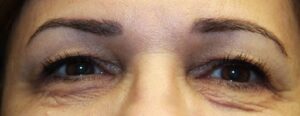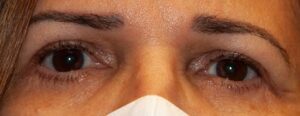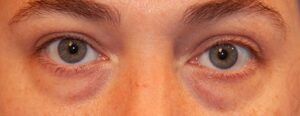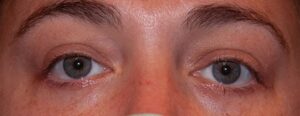Techniques for Avoiding Potential Lower Eyelid Surgery Complications
Lower eyelid surgery—also called lower eyelid blepharoplasty—is a facial plastic surgery procedure performed to achieve a refreshed, more youthful appearance by treating redundant eyelid tissue, displaced fat, crepey skin and wrinkles, and/or hollowing under the lids. The key to successfully creating an exceptional outcome that is both natural looking and long lasting lies in the surgeon’s ability to select and perform the correct lower eyelid blepharoplasty technique for each patient, as well as properly address specific anatomical variances that might lead to undercorrection or other possible complications if ignored.
To better illustrate this, we have provided two lower eyelid surgery cases below, both of which are actual patients treated by our facial plastic surgeon—Dr. Albert Cytryn.
Patient 1


Looking at the first patient, you can see there is a significant redundancy of lower eyelid skin with additional loss of the normal attachments that keep the skin firmly adherent to the underlying muscle. Several things need to happen to achieve the most optimal result. In addition to removing significant amounts of skin, the midface area needs to be undermined and re-draped so that the skin that isn’t removed is now tightly adherent to the underlying muscle. When this much skin is removed, there is always a potential for the eyelids to pull downwards as they heal. To avoid this complication, Dr. Cytryn routinely tightens the eyelid and midface. This extra step not only helps to avoid a potential pitfall but also augments the cosmetic result and brings the eyelid and cheek into a beautiful continuum that would otherwise not take place.
Patient 2


This second patient illustrates a much different anatomical presentation. She is much younger and does not have much, if any, loose skin. The biggest problem with this patient is the fat prolapsing from the eye socket into the eyelids and the dark circles that are created when the midface tissues become more hollow. In a patient such as this, Dr. Cytryn may or may not need to make an incision into the skin. The main component of the surgery is releasing the various ligaments that lead to the hollow areas under the eyelids. While some of the fat is removed, much of it is placed into a different position under the original fat pad, thereby eliminating the dark circles that are the most noticeable aspect of the patient’s pre-operative complaint. This technique is known as fat transposition.
Even though this patient is much younger than the first, tightening of the eyelid and cheek are important here, as well—both to minimize the potential for the eyelids to pull downwards and to augment the aesthetic outcome.
Key Takeaway
Every patient case is entirely unique—which requires the ability to choose and perform the proper technique(s) for the individual’s distinctive anatomical needs. If the surgeon truly understands what anatomical changes need to occur, and the proper tightening techniques are used, then the overall results should be outstanding. Unfortunately, not all practitioners who offer lower eyelid surgery are properly trained in the skills of eyelid and midfacial tissue tightening or the redraping of fat—which quite frequently leads to slight undercorrection and subpar outcomes for many patients who undergo this treatment.
Having undergone extensive oculoplastic surgery training—combined with his 20-plus years of experience—Dr. Cytryn is highly proficient in properly selecting and employing the techniques necessary to achieve optimal, long lasting results for his lower eyelid blepharoplasty patients. As a matter of fact, resolving complications related to previous procedures performed elsewhere makes up approximately 10 percent of his practice.
If you are interested in lower eyelid surgery, or if you are seeking revisional surgery after a prior treatment that yielded a sub-optimal outcome, please feel free to contact Cytryn Eyelid & Facial Plastic Surgery to book a consultation. Dr. Cytryn is happy to help!
